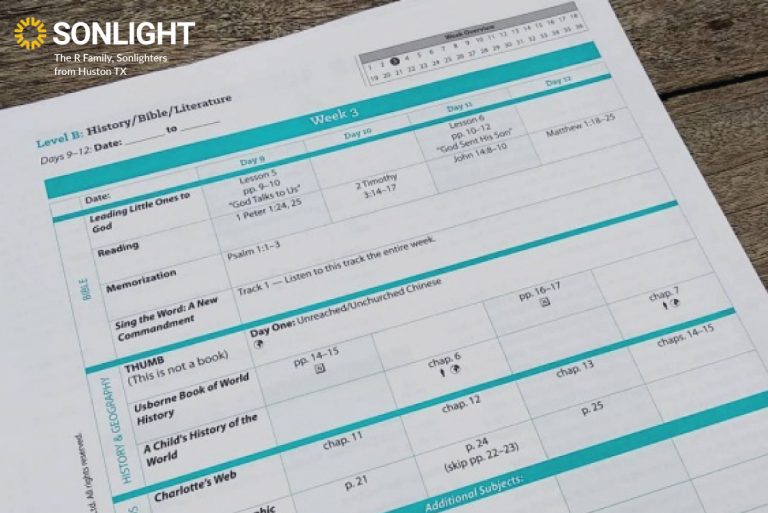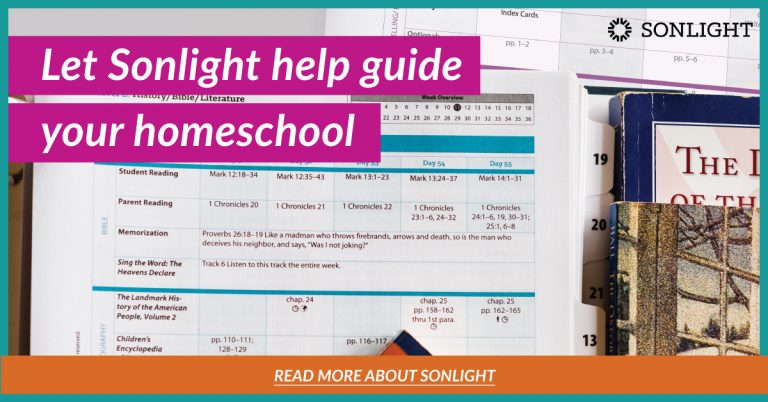When my family made the choice to homeschool our daughter, it was no small decision. Today almost 7, she had been in public school since age 3, getting needed therapies through a lengthy Individualized Education Plan (IEP).
Trading an IEP for a homeschool curriculum was scary. But it was the right decision. One of the best parts of choosing a Sonlight curriculum is that it is open-and-go, meaning your homeschool day is pre-planned for you. That might seem like a tall order for out-of-the-box kids. Yet after using Sonlight for several years with my own, I believe your Sonlight Instructor’s Guide is a powerful tool you can customize to fit your family’s preferences. Here are a few things you might consider.
1. Discover Your Child’s Learning Style
You know your family best. Consider the Instructor’s Guide (IG) your road map to homeschooling and use it as a launching point to create a learning environment tailored specifically for them.
With neurodiverse kids, the opportunity to teach to their strength is particularly important. While they may struggle with attention challenges in a traditional classroom, as their teacher you can choose curriculum and activities to keep them engaged.
- Do they learn visually?
- Through song?
- Or are hands-on activities more their style?
Your guide offers suggestions for activities to suit all learning styles, but you can always add others to supplement what best meets your student’s needs. My kids love Hands-on History kits, and learning styles are also a consideration when choosing a math curriculum. In our house, Math-U-See blocks often become cities or even people who talk with one another.
2. Allow for Interest-Based Learning
Many differently-wired kids may get laser focused on a topic or a subject and enjoy spending a lot of time in one area or finishing an entire week’s worth of reading in one day!
You might consider a loop schedule if this works for your family, focusing on one subject at a time, rotating so you never feel behind. Our family likes to supplement topics our kids are very interested in with library books, crafts, or videos. Supplementing works well if you happen to get ahead in reading or you’d like to delve deeper into a history or science topic.
3. Chunk Your Work
When my daughter had an IEP in public school, one of her accommodations was for her work to be broken into chunks to help her focus. Chunking can mean doing a few questions at a time or writing only small amounts.
By teaching our kids at home, we can chunk their work into a smaller, more manageable day than a typical, lengthy school day. And the great news is your Sonlight day is already chunked for you! You can open and go, choosing to group together as many boxes of your IG as you like–all, none, or a few at a time.
Most Sonlighters are familiar with Couch Time and Table Time. But for wiggly kids, sitting still for either one of those can be difficult. We’ve had luck breaking those up into shorter sections:
- Ten minutes of school work, followed by a brief break.
- Ten more minutes, then break.
For our family, that usually looks like one or two check boxes on our IG at a time. Chunking work can also mean physically chunking:
- Cutting Activity Sheets into sections
- Covering sections with another paper as you go
- Writing individual questions on notecards or on a white board
- Using task boxes (like these) as a fun way to promote independence and break work (or even play or therapy) into manageable sizes. (They’re great for spelling word activities and math manipulatives.)
4. Make Your Instructor’s Guide Work for You
Remember you’re on your own timetable. Your guide is set for 36 weeks, but the pace is up to you. Make sure you are meeting your state’s homeschooling requirements, but generally you can take longer (or less time) to complete your IG if you like. You may fly through some subjects but go more slowly on others. That’s ok!
In our family, we work at a different pace in each subject. As such, I keep our complete IG in a blue Sonlight binder and pull out just a week or two at a time of each subject into a smaller binder, to help keep track of different weeks at once.
Your guide can also be your one-stop planner. In our family we incorporate occupational and speech activities, scouting, and other extracurricular activities right into our guide. Therapy counts as school, too!
5. Put the Right Tools in Your Teaching Toolbox
When you’re working with an out-of-the-box thinker, you may need some out-of-the-box tools to keep your lessons on track. A few that have helped the Instructor’s Guide work for our family include:
- Visual timer: Using visual timers can help kids with ADHD and other neurotypical thinkers see time–and they provide a tangible reminder for you of how much time and attention your student can really devote to an activity.
- Laminated pockets or a laminator: Using any sort of material that helps you turn an Activity Sheet into a wipe-clean activity can help add variety and fun. Writing on a vertical white board can also help if your child has poor hand strength.
- A sensory diet: Think beyond the fidget spinner. A variety of sensory tools–or the right sensory diet, when appropriate–can help make your homeschool day run smoothly. Whether it’s starting your day with outdoor play, offering frequent breaks for heavy work around the house, or a simple basket of fidgets during Read-Alouds or wobble cushions for Table Time, there are many ways to incorporate this into your day. A tip we like in our family: write a sensory break right into your guide and check it off as you move through your schedule.
- Alternative seating: You’ve probably heard of using a yoga ball as a desk chair. But if your child is struggling to sit at a table, how about ditching the table altogether? Take table subjects to the floor, outside, or to whatever spot suits them best. At our house we love clipboards (with paper holders) for this.
6. Reach Out and Speak Up Because You Are Not Alone
At times, we can feel alone on this homeschool journey. But there are others who have been on journeys similar to yours, and mine. I’ve learned so much from other homeschool mamas, on this blog, in the Sonlight app and Facebook groups, and elsewhere.
Don’t be afraid to be honest, ask questions, and share your experience.
Remember God is using you to create something beautiful in your home. Your Sonlight Instructor’s Guide is a tool as you teach your children every day. As author Sally Clarkson writes in her book, Different, The Story of an Outside-the-Box Kid and the Mom Who Loved Him, “I often thought of my role in our home as that of a conductor of God’s beautiful music there–planning and directing the details of atmosphere and activity in ways that would convey His love, His mercy, and His grace to all who entered my home.”
Here’s to that song.








So well said. Even moms of "standard" kids (is there such a creature?) Can benefit from this advice.